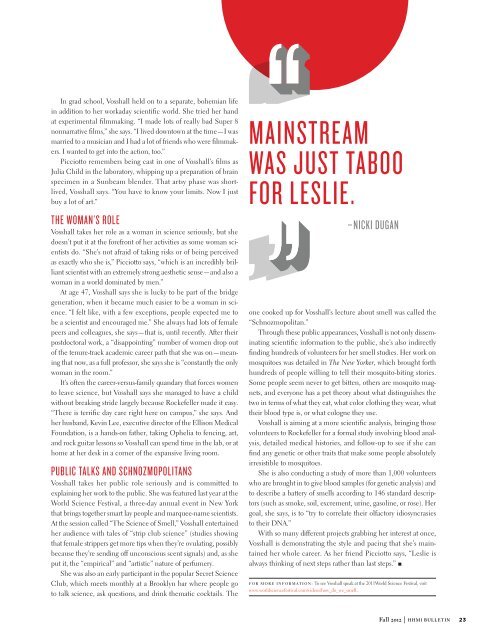Download PDF - Howard Hughes Medical Institute
Download PDF - Howard Hughes Medical Institute
Download PDF - Howard Hughes Medical Institute
You also want an ePaper? Increase the reach of your titles
YUMPU automatically turns print PDFs into web optimized ePapers that Google loves.
In grad school, Vosshall held on to a separate, bohemian life<br />
in addition to her workaday scientific world. She tried her hand<br />
at experimental filmmaking. “I made lots of really bad Super 8<br />
nonnarrative films,” she says. “I lived downtown at the time—I was<br />
married to a musician and I had a lot of friends who were filmmakers.<br />
I wanted to get into the action, too.”<br />
Picciotto remembers being cast in one of Vosshall’s films as<br />
Julia Child in the laboratory, whipping up a preparation of brain<br />
specimen in a Sunbeam blender. That artsy phase was shortlived,<br />
Vosshall says. “You have to know your limits. Now I just<br />
buy a lot of art.”<br />
The Woman’s Role<br />
Vosshall takes her role as a woman in science seriously, but she<br />
doesn’t put it at the forefront of her activities as some woman scientists<br />
do. “She’s not afraid of taking risks or of being perceived<br />
as exactly who she is,” Picciotto says, “which is an incredibly brilliant<br />
scientist with an extremely strong aesthetic sense—and also a<br />
woman in a world dominated by men.”<br />
At age 47, Vosshall says she is lucky to be part of the bridge<br />
generation, when it became much easier to be a woman in science.<br />
“I felt like, with a few exceptions, people expected me to<br />
be a scientist and encouraged me.” She always had lots of female<br />
peers and colleagues, she says—that is, until recently. After their<br />
postdoctoral work, a “disappointing” number of women drop out<br />
of the tenure-track academic career path that she was on—meaning<br />
that now, as a full professor, she says she is “constantly the only<br />
woman in the room.”<br />
It’s often the career-versus-family quandary that forces women<br />
to leave science, but Vosshall says she managed to have a child<br />
without breaking stride largely because Rockefeller made it easy.<br />
“There is terrific day care right here on campus,” she says. And<br />
her husband, Kevin Lee, executive director of the Ellison <strong>Medical</strong><br />
Foundation, is a hands-on father, taking Ophelia to fencing, art,<br />
and rock guitar lessons so Vosshall can spend time in the lab, or at<br />
home at her desk in a corner of the expansive living room.<br />
Public Talks and Schnozmopolitans<br />
Vosshall takes her public role seriously and is committed to<br />
explaining her work to the public. She was featured last year at the<br />
World Science Festival, a three-day annual event in New York<br />
that brings together smart lay people and marquee-name scientists.<br />
At the session called “The Science of Smell,” Vosshall entertained<br />
her audience with tales of “strip club science” (studies showing<br />
that female strippers get more tips when they’re ovulating, possibly<br />
because they’re sending off unconscious scent signals) and, as she<br />
put it, the “empirical” and “artistic” nature of perfumery.<br />
She was also an early participant in the popular Secret Science<br />
Club, which meets monthly at a Brooklyn bar where people go<br />
to talk science, ask questions, and drink thematic cocktails. The<br />
Mainstream<br />
WAs just taboo<br />
for Leslie.<br />
FOR MORE INFORMATION: To see Vosshall speak at the 2011World Science Festival, visit<br />
www.worldsciencefestival.com/videos/how_do_we_smell.<br />
–Nicki Dugan<br />
one cooked up for Vosshall’s lecture about smell was called the<br />
“Schnozmopolitan.”<br />
Through these public appearances, Vosshall is not only disseminating<br />
scientific information to the public, she’s also indirectly<br />
finding hundreds of volunteers for her smell studies. Her work on<br />
mosquitoes was detailed in The New Yorker, which brought forth<br />
hundreds of people willing to tell their mosquito-biting stories.<br />
Some people seem never to get bitten, others are mosquito magnets,<br />
and everyone has a pet theory about what distinguishes the<br />
two in terms of what they eat, what color clothing they wear, what<br />
their blood type is, or what cologne they use.<br />
Vosshall is aiming at a more scientific analysis, bringing those<br />
volunteers to Rockefeller for a formal study involving blood analysis,<br />
detailed medical histories, and follow-up to see if she can<br />
find any genetic or other traits that make some people absolutely<br />
irresistible to mosquitoes.<br />
She is also conducting a study of more than 1,000 volunteers<br />
who are brought in to give blood samples (for genetic analysis) and<br />
to describe a battery of smells according to 146 standard descriptors<br />
(such as smoke, soil, excrement, urine, gasoline, or rose). Her<br />
goal, she says, is to “try to correlate their olfactory idiosyncrasies<br />
to their DNA.”<br />
With so many different projects grabbing her interest at once,<br />
Vosshall is demonstrating the style and pacing that she’s maintained<br />
her whole career. As her friend Picciotto says, “Leslie is<br />
always thinking of next steps rather than last steps.” W<br />
Fall 2o12 | h h m i b u l l e t i n<br />
23
















